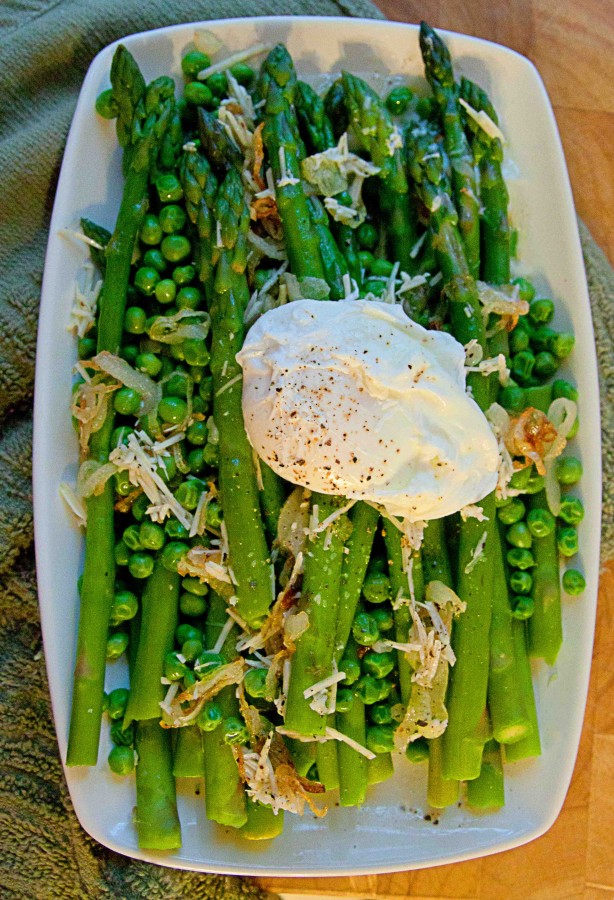loading...
Last Saturday, I had the pleasure of joining the Crescent City Farmer’s Market folks in New Orleans for a cooking demonstration using spring produce. Unlike Red Stick, Crescent City’s market is less of a leisurely stroll down Main Street and more of a busy, square parking lot stuffed full of people and food.
Although we may not have vendors selling rare finds like Avocado Popsicles, both of our Saturday markets are blessed with local farms specializing in seasonal produce: Ponchatoula strawberries are a must this time of year, and my favorite—sweet spring peas and stalks of asparagus.
While there are a variety of ways to cook asparagus (I prefer roasted or grilled), properly preparing the vegetable is just as important. Unlike most greens that just require a good scrub, asparagus demands one extra step: dealing with those woody ends. If you’ve ever made the mistake of forgetting to trim your asparagus before cooking, you’ll easily remember a few chewy, uncomfortable bites towards the ends of the spear.
No matter how fresh, asparagus will always be a little dry and dehydrated at the bottom, making it highly unpleasant to eat.
Since I first began cooking asparagus, I’ve always been taught to “snap” off the woody ends. Simply hold the stalk between two hands, gripping the dry, woody end tightly in one hand. Then, flex the stalk backwards and the woody end “snaps” right off. Although this tip is easy (and fun, especially when cooking with children), it wastes a significant amount of good-for-you greens, sometimes even reducing the stalk by more than a third.
Fortunately, there are other solutions.
Lately, I’ve been “shaving” the ends. Trim the bottom of the stalk ½ inch up and using a sharp peeler, shave down the pale, tough end that’s left behind. You’ll waste less of the stalk and remove unnecessary toughness before cooking.
To make the most of spring asparagus, here are some other common problems, tips and tricks:
Limp, lifeless asparagus? Try rehydrating the stalk. Cutting at an angle, trim the stalk ½-inch up from the woody end. Wash stalks thoroughly and place upright in a vase filled with room-temperature water (as with flowers). Check back in an hour, and your greens will be brought back to life.
Avoid dehydration—when you get home, wash the stalks (or give them a good soak), removing any strings or bands. Wrap and store asparagus in a moist paper towel to prevent drying out.
Recycle stems—if you do choose to “snap” the stalk, there’s an easy way to put leftovers to good use: vegetable broth. Combine asparagus pieces with fresh herbs, salt, pepper and your choice of chopped carrots, celery and onions. Simmer in just enough water for the vegetables to “float” on medium-low heat for up to an hour. Reserve and refrigerate the leftover broth for soups and vegetarian dishes.
Size matters—as tempting as it is to buy delicate, thin asparagus, the thicker the stalk, the better your results. In fact, Alton Brown notes that although thicker stalks are no more fibrous than thinner ones, they sure do look (and taste) a whole lot better.
As always, make sure to buy shiny spears with thick flowering tips (loose tips indicate a lack of freshness), and introduce them to some other spring vegetables like sweet peas and shallots.
Asparagus, Shallots, & Spring Peas in Parmesan Vinaigrette
(optional ingredient: poached egg)
Serves: 6-8
Ingredients:
—Parmesan Vinaigrette—
*5 tablespoons extra virgin olive oil
*3 tablespoons lemon juice
*3 tablespoons Parmesan, grated
*Salt and pepper, to taste
—Vegetables—
*1 bunch asparagus, washed and trimmed
*1 cup shelled peas (can substitute fresh, frozen)
*2 shallots, thinly sliced
*1 tablespoon olive oil
*2 tablespoons vegetable oil
*Salt and pepper, to taste
*poached egg (optional)
1.) Preheat oven to 350F. Whisk together olive oil, lemon juice, Parmesan, salt and pepper to taste. Set aside.
2.) Wash asparagus and remove woody ends. Shell peas and thinly slice shallots. Transfer asparagus to a lined roasting pan (I prefer using a Silpat mat), spreading evenly over surface. Drizzle with olive oil and season with salt and pepper to taste, tossing to coat. Roast for at least 15 to 20 minutes, flipping occasionally until asparagus is tender (do not overcook).
3.) In a nonstick skillet, warm vegetable oil over medium heat and add shallots. Stir occasionally until golden brown (about 8 to 10 minutes).
4.) Add peas to skillet and sauté until onions are crispy and peas have begun to brown slightly.
5.) Toss asparagus with peas and onions and dress in vinaigrette. Optional: top with poached egg.
*Note: one of my favorite ways to serve roasted asparagus is during brunch with poached eggs (pictured). But this dish makes a lovely spring side for any meal, egg or not.
—
Follow me on Pinterest: http://pinterest.com/helana/
Twitter: https://twitter.com/DancesWLobsters
Facebook: https://www.facebook.com/pages/Clearly-Delicious/103136413059101
Tumblr: http://clearlydelicious.tumblr.com/
Instagram: http://instagram.com/helanabrigman
Asparagus, Shallots, & Spring Peas in Parmesan Vinaigrette,


1 Comment
The Omnivore
April 17, 2013 at 1:08 pmThanks for the great tips! I’ve always snapped my asparagus but now I’ll try shaving them. And the recipe looks wonderful — bookmarked!